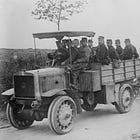The difficulties experienced in completing the peacetime establishment of the 2nd Heavy Artillery Regiment makes it clear that any further expansion of the mobile heavy artillery of the French Army could only be achieved by the conversion of existing units. Moreover, as Plan XVII made full use of existing field batteries and the vast majority of the remaining fortress batteries were stationed near the German frontier, the most likely candidates for conversion were coast defense batteries. Indeed, the same considerations that had led the French authorities to employ coast defense batteries as a means of filling out the orders of battle of the five original heavy artillery regiments continued to hold true. Chief among these were the Entente Cordiale with Great Britain, the likelihood of Italian neutrality in the event of a European war, and growing confidence in the ability of second-line units, whether reserve or territorial, to take charge of coastal fortifications. With the possible exception of three batteries at Dunkirk, the coast defenses of France, as well as those of French North Africa, had been erected to protect French ports from British or Italian warships, not German ones.
The cadre law of 15 April 1914 gave the war minister the right to make organizational changes of a sort that had previously been the prerogative of the National Assembly. These changes included the transformation of fortress artillery regiments into heavy artillery regiments, the conversion of batteries of one type into batteries of another sort and the repatriation of coast defense batteries stationed in North Africa. While the exercise of any of these decisions required the concurrence of the finance minister, these new powers would have greatly facilitated the further conversion of coast defense batteries into heavy artillery batteries. In particular, by removing such decisions from the realm of parliamentary debate, they reduced the ability of the representatives of coastal communities to impede the conversion of local coast defense batteries.[20]
Just how many additional coast defense batteries would have been converted into heavy artillery units is difficult to establish. It is clear that General Joffre wished to provide at least three batteries of the new 105mm heavy guns to each of the twenty-one army corps called for by Plan XVII.[21] It is likely that he wanted to provide each army with one or two groups of heavy field howitzers (whether the Rimailho or its eventual replacement). Finally, it is quite possible that he wished to keep, as a complement to the long-range heavy guns of 4th Heavy Artillery Regiment, a few batteries of super-heavy field howitzers such as the 210mm ‘field mortars’ that the armaments firm of Schneider had recently developed for Russia. With this in mind, it is reasonable to assume that Joffre was actively considering the formation of as many as fifty additional batteries of mobile heavy artillery. As one coast battery was sufficient to create the nucleus of two mobile heavy batteries, the achievement of such a program would have required the sacrifice of twenty-five coast defense batteries, which was exactly how many were left in France and North Africa after the five heavy artillery regiments had been formed on 1 May 1914.
Unless someone uncovers a long-forgotten ‘wish list’ in an archive or diary, we will never know the exact parameters of the heavy artillery establishment that Joffre would have tried to create had the war not interrupted his efforts. Indeed, given the way that Joffre preferred to operate – by creating situations that allowed him to exploit opportunities – it is quite possible that he had yet to lay out a firm agenda for the further development of that arm. What is clear, however, is that, notwithstanding the additional resources made available by the adoption of three-year service, any significant expansion of one part of the French Army could only be achieved at the expense of another.
Notes:
[20] Joffre would later characterize the opposition to the transfer of coast defense batteries as ‘vehement’. Joffre, Mémoires, pp. 64-65
[21] Joffre, Mémoires, p. 71
This is the penultimate post in The Phantom Batteries of Plan XVII. For links to the other posts in this series, please make use of the following aggregator:
To Subscribe, Support, or Share:
.







